This post may contain affiliate links. See my disclosure policy.
This Norwegian Salt Cod Stew, or Bacalao from the Spanish word for cod, is a recipe made with salt cod, olive oil, stewed tomatoes, garlic, shallots, and potatoes. One of Norway’s most foreign (and popular) stew recipes, learn all about the history and export of Norway’s salt cod and the unexpected Spanish influence over its preparation in the 19th century.
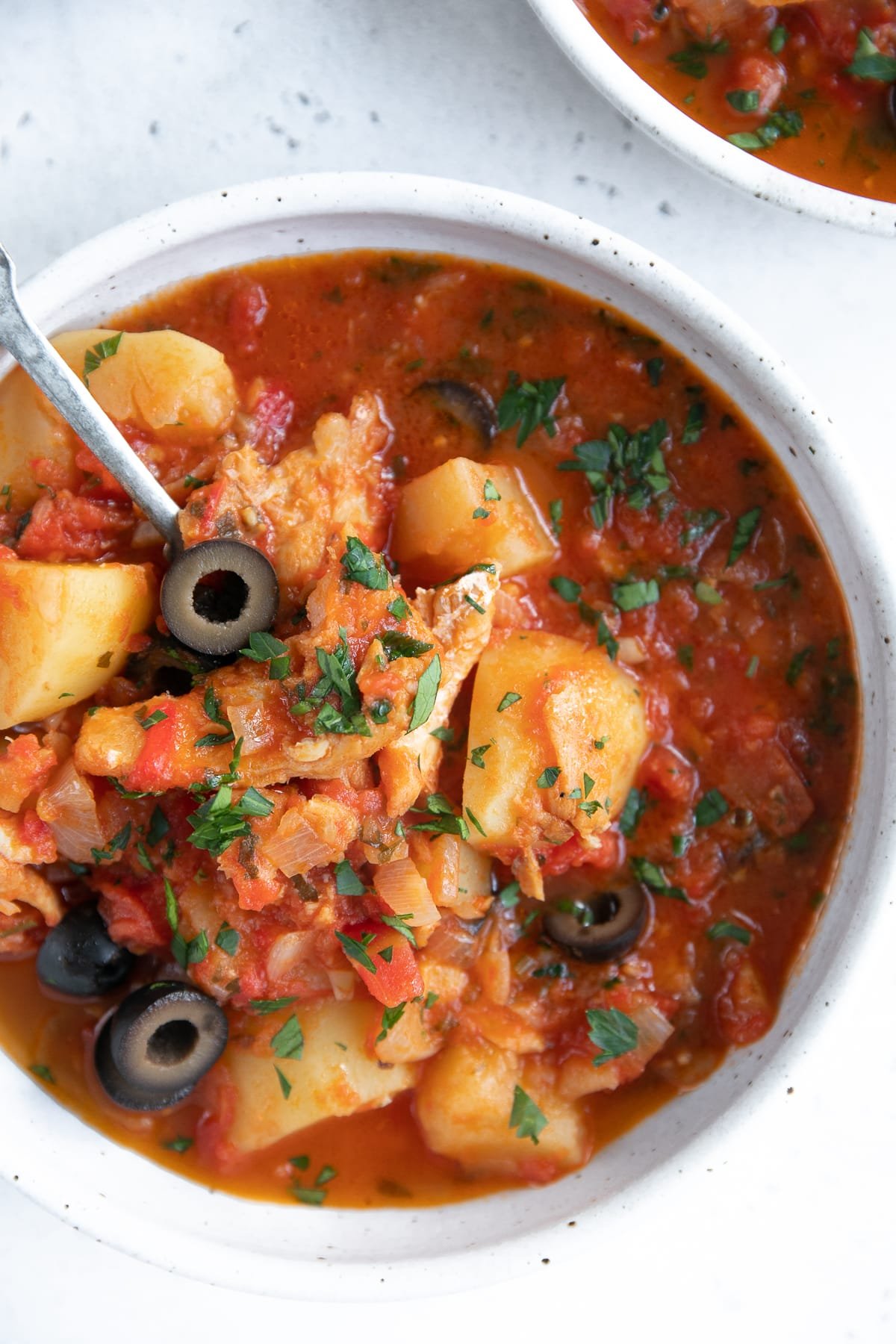
Bacalao
After traveling through northern Norway back in May 2019, a few key things remain engraved in my memory,
- The overwhelming, breathtaking beauty. No really, absolutely jaw-dropping.
- The lack of alcohol…and convenient stores. This, of course, is part of what keeps it so beautiful- there isn’t a strip mall around every corner. But, alcohol (aside from beer) is only sold on certain days of the week and, depending on where you stay, it may take you 2 hours to get you to a place that actually sells it.
- The food is heavy. Creamy carrots, fried cod, creamy soups, lots of bacon, so many stewed potatoes, and, of course, bacalao.
Norway was an incredible experience and I would happily go back in a heartbeat. Especially if it meant savoring more of their popular salt fish stew.
Table of Contents
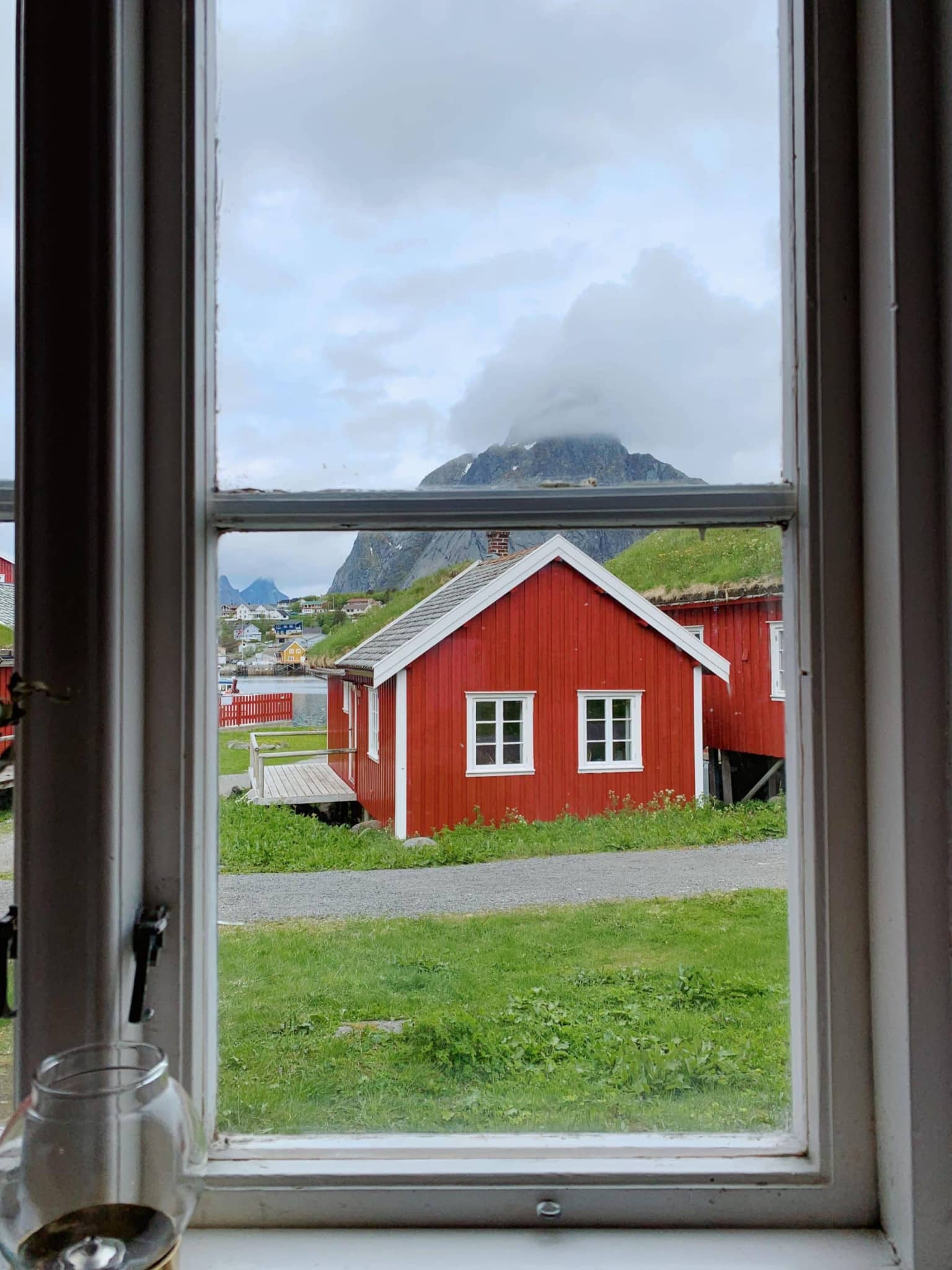
What is Salt Cod?
Salt cod – also referred to as saltfish or klippfisk (from the Norwegian translation cliff-fish), bacalhau in Brazil and Portugal, or baccalà in Italy – is cod that has been preserved by drying after salting.
The process starts soon after catching and often while still on board the ship. The fish are beheaded and gutted (possible with whitefish, such as cod, but not with oily fish). The fish is then salted and dried ashore. Traditional salt fish production would have then transported the fish to rocks or wooden frames to dry in the sun, but commercial production is now done indoors with electrical heating.
History of Norway’s Famous Fish
From the time of the Vikings, stockfish (dry unsalted cod) played a huge role in surviving Norway’s long and dark winters. Adding salt to cod is a method that has been around since the 15th century. It wasn’t until the 17th century, however, when cheap salt from southern Europe became available to the maritime nations of northern Europe, that it became economically feasible.
Why add salt? The addition of salt adds extra flavor, of course! It’s also an additional layer of preservation as salt has antibacterial properties making it suitable for storing at warmer temperatures. This extra layer of protection proved especially important for countries like Spain and Portugal.
In the 18th century, Norway started exporting great amounts of salt cod to Catholic countries like Spain, Italy, and Portugal, where it quickly became a staple item in their diet for ‘meatless’ Fridays and during Lent.
Why is it called bacalao?
It was through this relationship with their neighbors to the south that salt cod stew, or bacalao, was born. Heavily influenced by Spanish ingredients like garlic, olive oil, olives, and tomatoes, it seems that the only ingredient familiar to the Norwegians (at that time) would have been the salt cod.
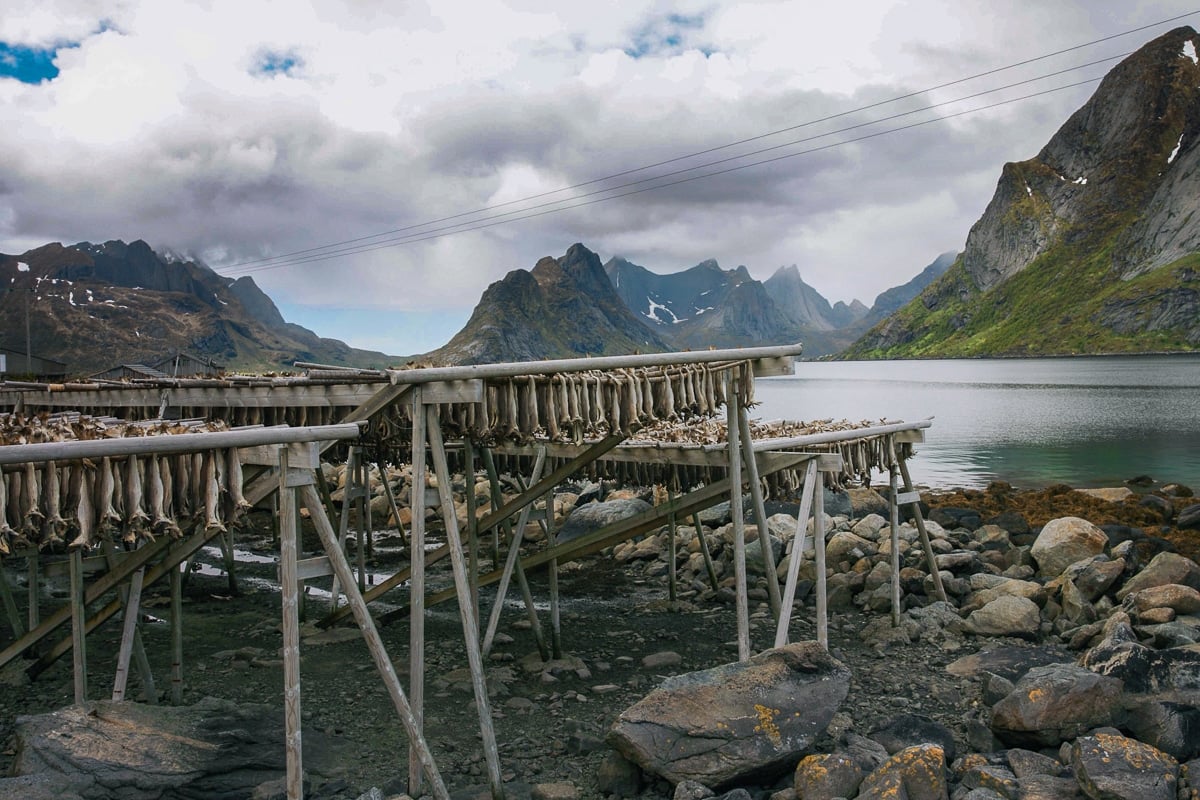
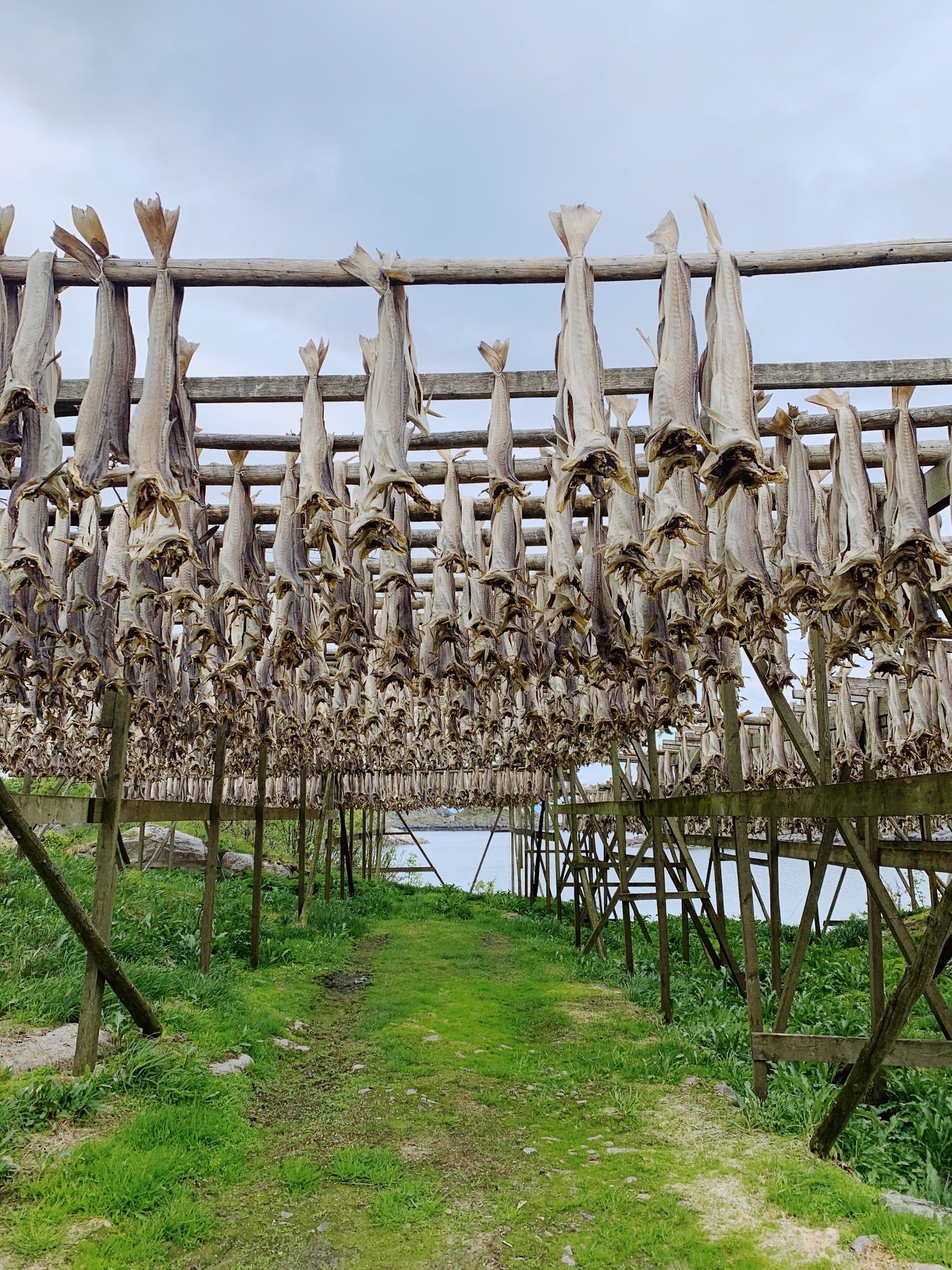
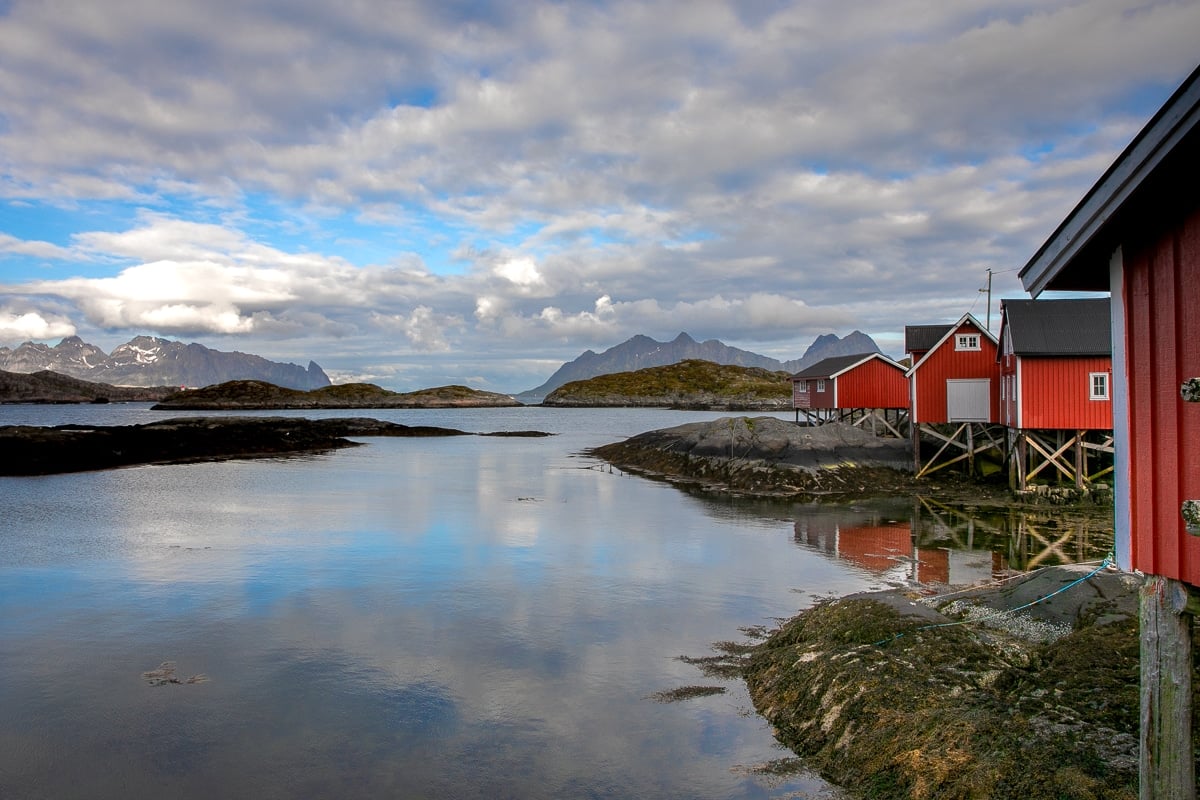
Key Ingredients
For the full list and amounts of ingredients, scroll down to the recipe card at the bottom of the page.
Salted Cod Fish: You can purchase salt cod either whole, bone-in, skin-on which typically ranges from 1-5 pounds OR packaged boneless, skinless filets. The latter is pricier but more widely available. If your local supermarket doesn’t carry salt cod, ask them if they can special order it for you.
Olive oil: Three-quarters of a cup of olive oil may sound like an insane amount of olive oil, but compared to many bacalao recipes, this is actually quite reasonable. I recommend using good-quality olive oil. I also recommend using the full amount listed. You can add more if you’d like.
Garlic and shallots: These are your aromatics. They’re also essential to the overall flavor of your recipe. If preferred, replace the shallots with 2-3 medium, thinly sliced onions.
Red Chili: Feel free to omit the chili if you’re sensitive to spicy food. You may also substitute with 1-2 teaspoons of red chili flakes.
Dry Sherry: The dry sherry is optional. Substitute with chicken or fish broth if you don’t have any on hand or you prefer not to cook with alcohol.
Broth: Feel free to add any type of broth – chicken, fish, clam, or vegetable.
Potatoes: White, waxy potatoes are key to this recipe. Unlike starchy potatoes (russet potatoes, for example) waxy potatoes hold their shape even after cooking. Try to purchase New Potatoes or Red Bliss Potatoes. Can’t find these? Yukon gold are a great all-around potato. Depending on the size of your potatoes, quarter, halve, or slice them. Next time I will slice my potatoes into 1/2-inch thick slices.
Tomatoes: As you can see, tomatoes play a huge role in this recipe. If you find yourself with a leftover supply of fresh tomatoes feel free to use those, otherwise, grab a few tins of chopped tomatoes and use those in its place.
Pimentos: Pimentos are a variety of large, red, heart-shaped chili peppers that are typically sold in jars after they’ve been pureed and formed into thin strips. Typically sweet, some varieties of the pimento may be hot. This recipe can be made with either jarred pimentos or roasted jarred red bell peppers.
Black Olives: Although it was probably more traditional to see kalamata olives in bacalao, these days you’ll often see black olives, kalamata, green olives, or no olives at all. Olives, of course, do not grow in Norway, but they do grow in Spain and Portugal.

How to make Norwegian Salt Cod Stew
Start by soaking your cod: this recipe does come with a little forethought. And by little, I mean at least 18-24 hours. Since your cod has been preserved in salt, it’s pretty important to rinse away (and rehydrate) your cod as much as possible before cooking.
- For boneless salt cod filets: Transfer fish to a large bowl and rinse thoroughly with cold, fresh, running water for approximately 5 minutes. Then soak for 18-24 hours in the refrigerator, changing the water at least 3 times.
- For whole, bone-in filets: Transfer fish to a large bowl and rinse thoroughly with cold, fresh, running water for approximately 5 minutes. Soak for 36-48 hours in the refrigerator, changing the water at least 4 times.
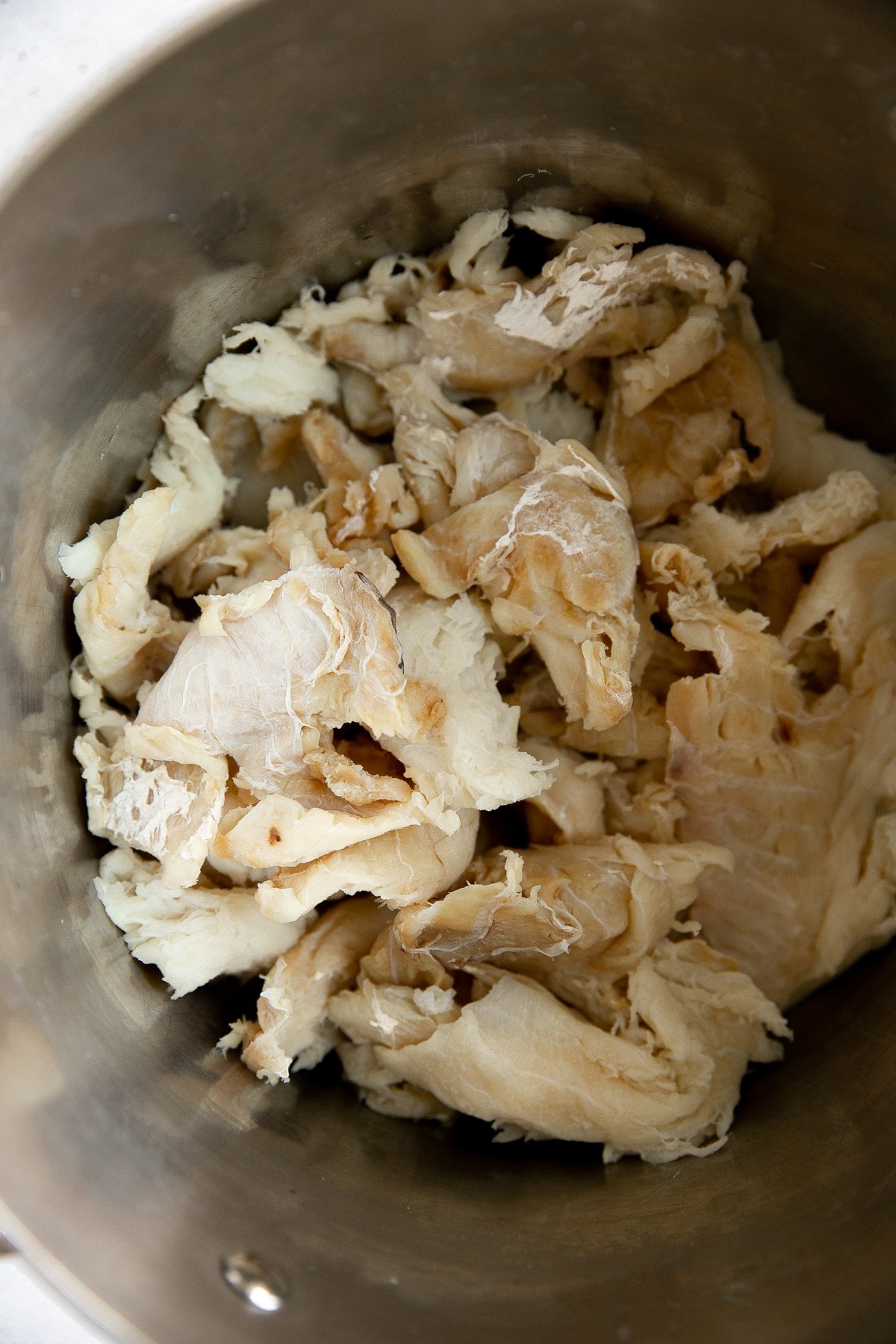
After soaking, cook the aromatics. Heat a large pot or Dutch oven over medium heat. Add the olive oil, garlic, and chilis and cook, stirring continuously for 2 minutes. Don’t burn your garlic and chilis, so keep stirring. Next, add your sliced shallots and a pinch of salt. Cook for 5-7 minutes, stirring often.
- I realize this may seem like a lot of shallots at first. Don’t worry. Shallots, like onions, cook down to nearly nothing.
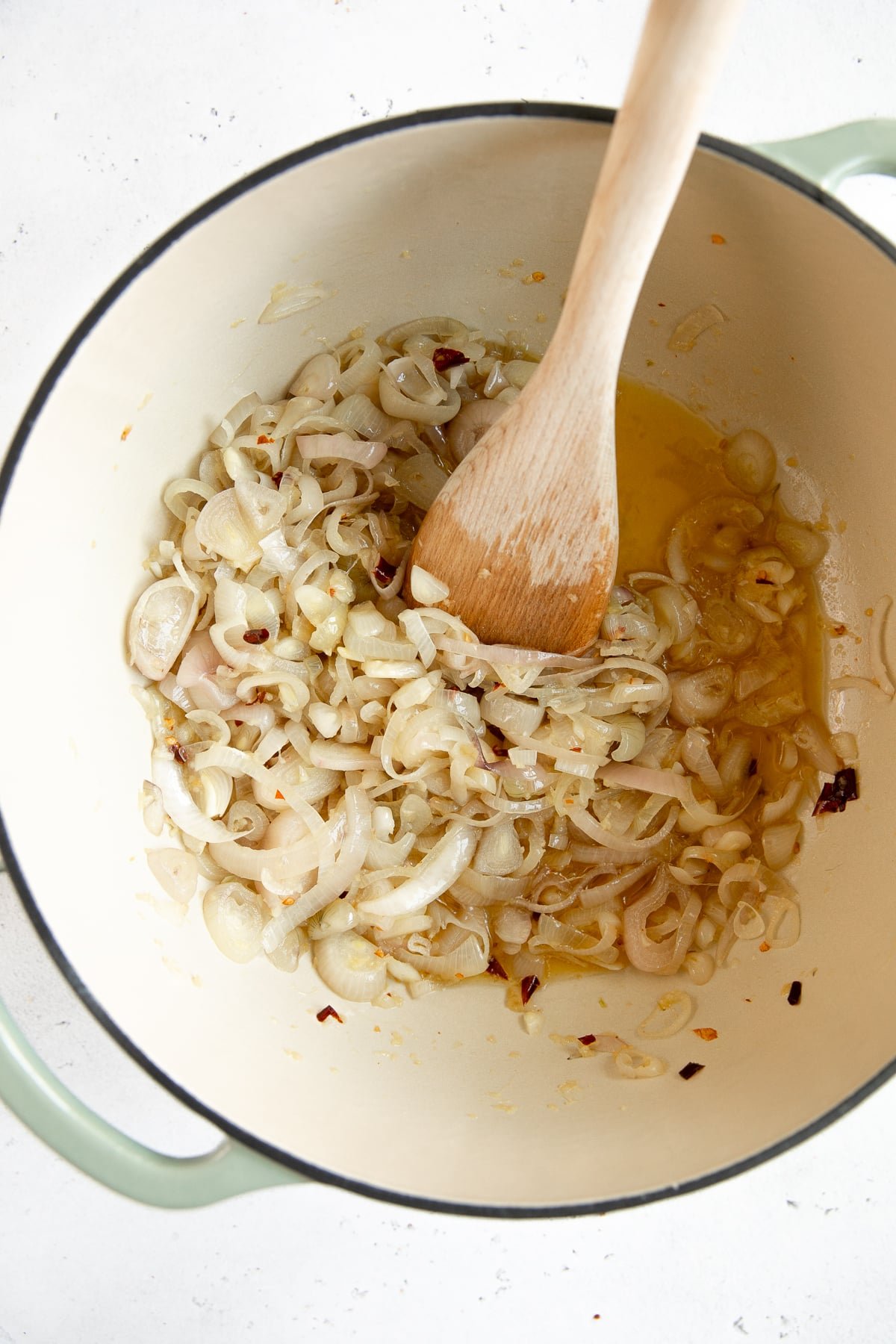
Make your stew. Add the tomatoes, dry sherry, and broth to your pot. Increase heat to high and bring to a gentle boil. Add the potatoes and mix well to cover the potatoes in the sauce. Cover with a tight-fitted lid and reduce heat to low. Continue to simmer, covered, for at least 60 minutes, or until the potatoes are nearly cooked.
- Feel free to add more broth to your sauce if you prefer a more soup-like stew. On the other hand, if your stew is too brothy, uncover and allow to simmer until the desired thickness is reached.
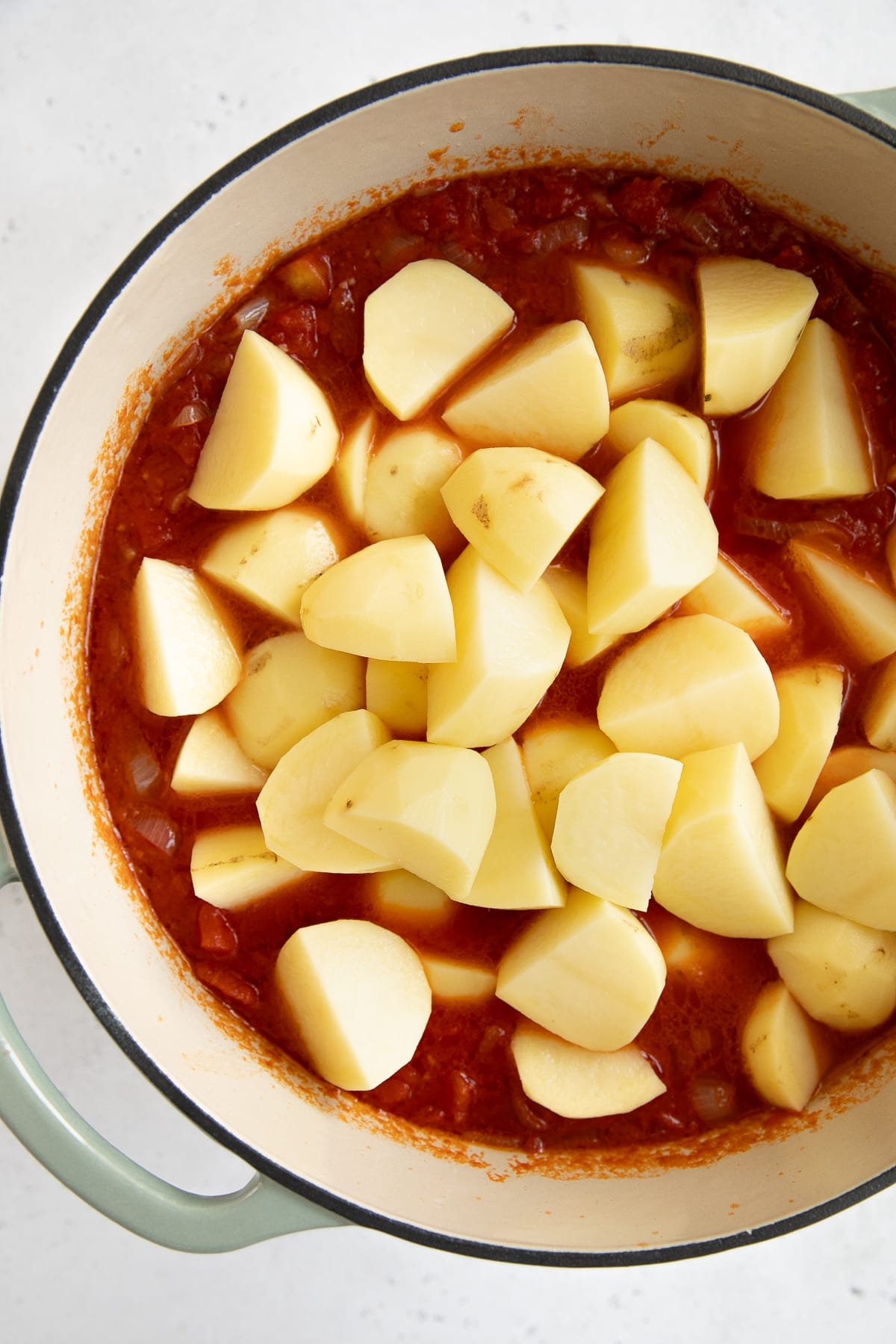
Make your stew. Add the tomatoes, dry sherry, and broth to your pot. Increase heat to high and bring to a gentle boil. Add the potatoes and mix well to cover the potatoes in the sauce. Cover with a tight-fitted lid and reduce heat to low. Continue to simmer, covered, for at least 60 minutes, or until the potatoes are nearly cooked.
- Feel free to add more broth to your sauce if you prefer a more soup-like stew. On the other hand, if your stew is too brothy, uncover and allow to simmer until the desired thickness is reached.
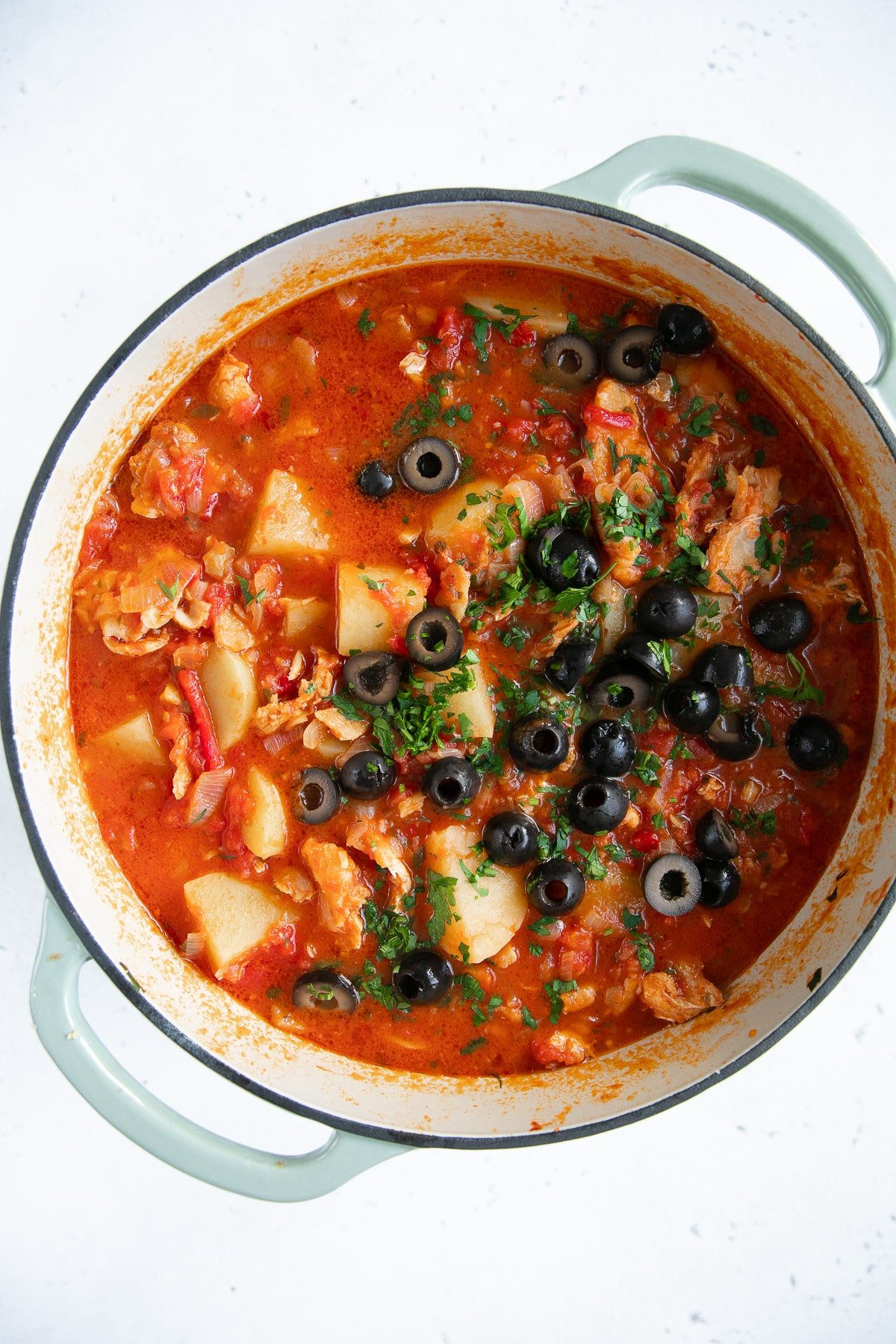
There Are Many Bacalao Recipe Versions
Anytime I prepare a recipe that represents a country different from my own I feel like I need to stress that, in all likelihood, it’s probably not authentic. For this recipe, I feel like the lines are a bit blurred. In my research, I found about a million different ways to make “bacalao”. Of course, there’s the Spanish, Portuguese, Puerto Rican, and Italian versions, but there’s also a handful of ways to prepare the Norwegian version. Some make it in a layer- like a casserole, while others add so much olive oil I couldn’t understand how it could possibly taste like anything else.
None of these versions represented the salt cod stew that I ate in Norway. And I didn’t eat it just once, you guys. Between my husband and me, we ate bacalao at least once a day for two weeks straight.
Long story short, this is the version most familiar to me. The version I enjoyed while traveling from Tromso all the way down to the end of the Lofoten islands. The only change I will make next time? Slice my potatoes.
How to Store Leftover Bacalao
This bacalao recipe makes quite a large pot so unless you plan to feed a large family, expect some leftovers. To store leftovers, allow your leftover stew to cool slightly at room temperature before transferring to the refrigerator. Keep stored in a covered pot or container until you’re ready to enjoy it again. You may reheat in the microwave, or, for best results, reheat on the stovetop. Enjoy within 4 days.

More fish recipes,
- Jamaican Jerk Cod with Mango Avocado Salsa
- Cioppino Recipe (Seafood Stew)
- Baked Cod Recipe
- Mediterranean Baked Fish
- Ceviche Recipe
- Pineapple Coconut Thai Fish Curry
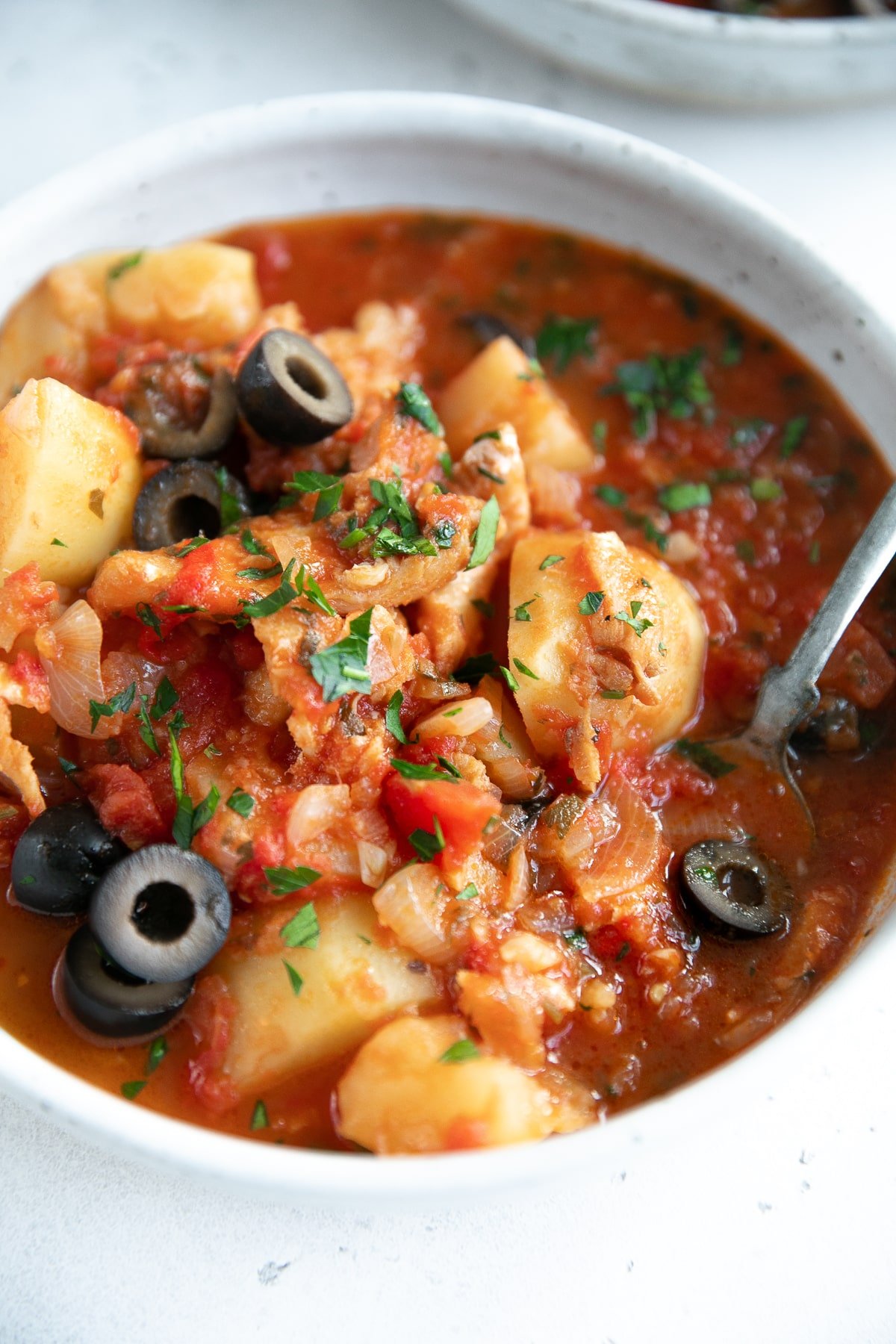
If you try making this Norwegian Salt Cod Stew (Bacalao), please leave me a comment and let me know! I always love to read your thoughts and feedback!
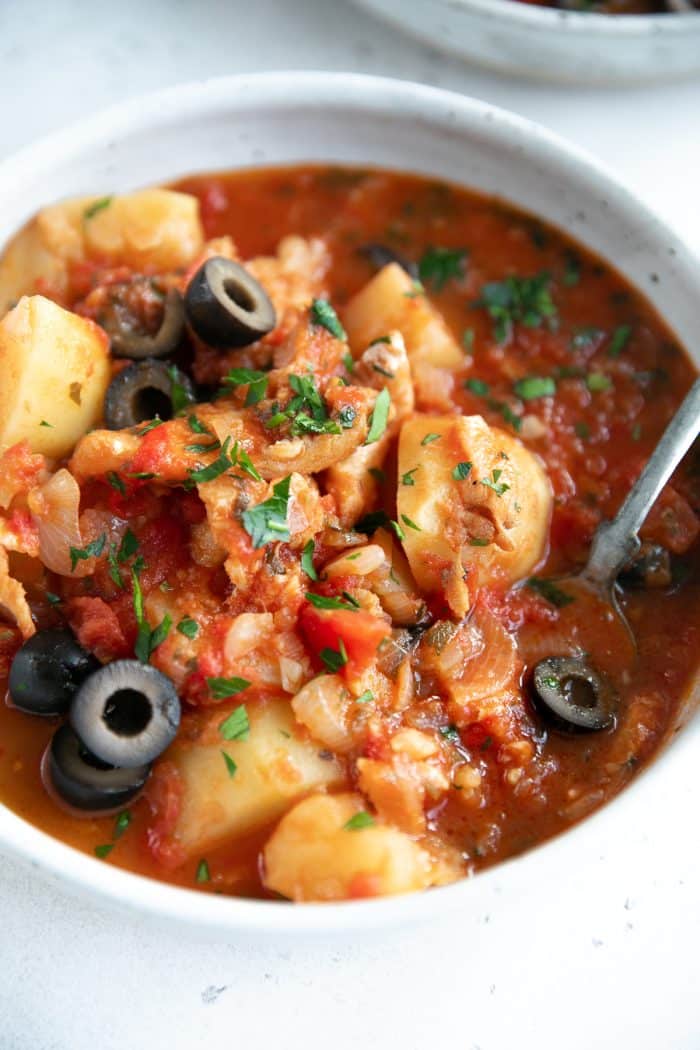
Norwegian Salted Cod Stew (Bacalao Recipe)
Ingredients
- 2 pounds salted cod
- ¾ cup olive oil
- 6 cloves garlic, minced
- 2 dried red chilis, stem removed and minced
- 16 large shallots, peeled and sliced
- salt and pepper, to season
- 2 (28 ounce) cans quality chopped tomatoes, e.g. Mutti
- 1 (28 ounce) cans quality whole peeled tomatoes, e.g. Mutti
- ¼ cup dry sherry
- ½ cup broth, plus more as needed
- 3 pounds waxy new potatoes, peeled and quartered or sliced
- 4 ounces jarred sliced pimentos
- ¼ cup fresh parsley, minced
- 1 cup black olives, sliced
Instructions
- Soak the salt cod––For boneless salt cod filets: Transfer fish to a large bowl and rinse thoroughly with cold, fresh, running water for approximately 5 minutes. Then soak for 18-24 hours in the refrigerator, changing the water at least 3 times.–For whole, bone-in filets: Transfer fish to a large bowl and rinse thoroughly with cold, fresh, running water for approximately 5 minutes. Soak for 36-48 hours in the refrigerator, changing the water at least 4 times.
- Cook the aromatics. Heat a large pot or Dutch oven over medium heat. Add the olive oil, garlic, and chilis and cook, stirring continuously for 2 minutes. Add the sliced shallots and a pinch of salt. Cook for 5-7 minutes, stirring often.
- Make your stew: Add the tomatoes, dry sherry, and broth to your pot. Increase heat to high and bring to a gentle boil. Add the potatoes and mix well to cover the potatoes in the sauce. Cover and reduce heat to low. Continue to simmer, covered, for at least 60 minutes, or until the potatoes are nearly cooked.
- Add the sliced drained cod: Continue to cook, covered, for 15-25 minutes. Approximately 5 minutes before serving stir in the sliced black olives and chopped pimentos.
- Season to taste and serve: Garnish with fresh chopped parsley and season with additional salt and pepper, to taste. Serve with toasted bread and sour cream, if desired.
Notes
- Salted Cod Fish: You can purchase salt cod either whole, bone-in, skin-on which typically range from 1-5 pounds OR packaged boneless, skinless filets. The latter is pricier, but more widly available.
- To my American friends, I understand that salted cod fish can be very difficult to track down here in the states. I found mine at Whole Foods, but perhaps you can find it online. No luck? Fresh cod will also work. Simply chop into cubes and add it at the same time that you would add the salted cod.
- Red Chili: Feel free to omit the chili if you’re sensitive to spicy food. You may also substitute with 1-2 teaspoons of red chili flakes.
- Dry Sherry: The dry sherry is optional. Substitute with chicken fish broth.
- Broth: Feel free to add any type of broth – chicken, fish, clam, or vegetable.
- Potatoes: You may either quarter or slice your potatoes. If your potatoes are small (like super small) skip peeling and simply chop in half. If they’re small/medium, peel or chop. And if they’re on the medium to large size, I recommend slicing them.
Nutrition
Nutrition information is automatically calculated, so should only be used as an approximation.


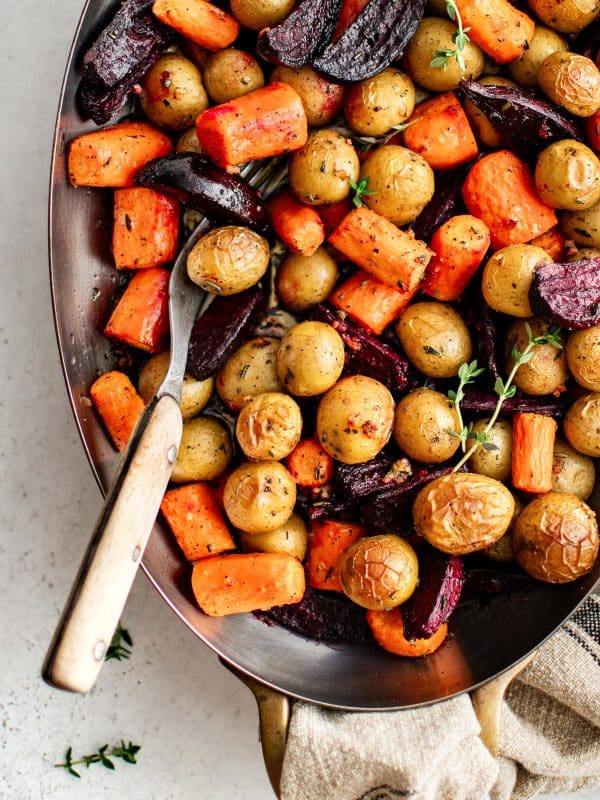
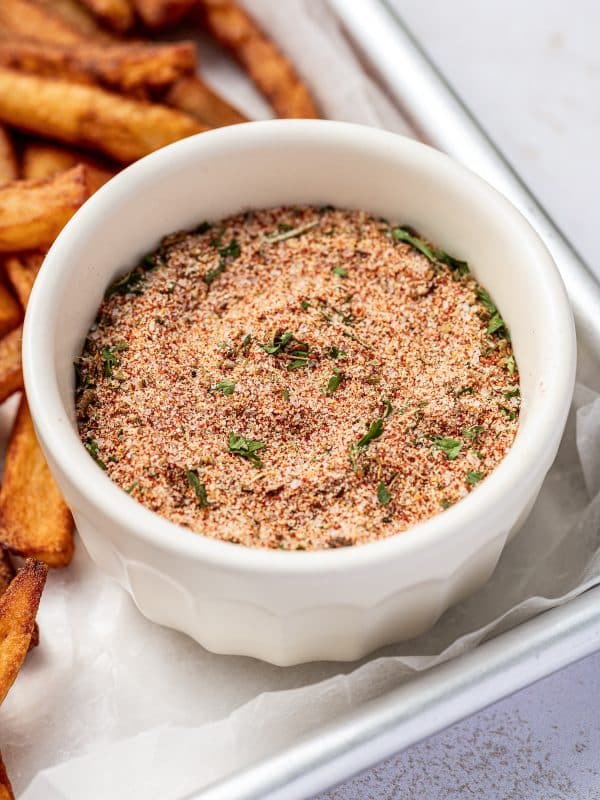
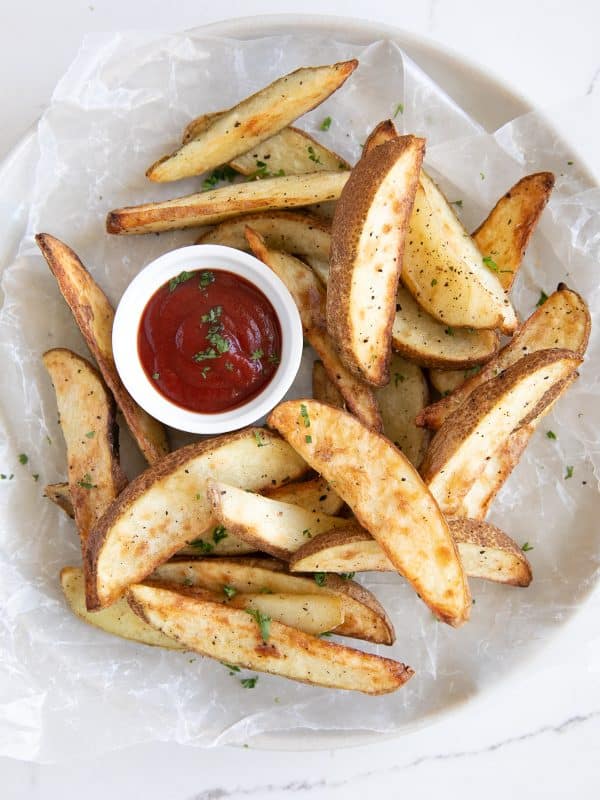
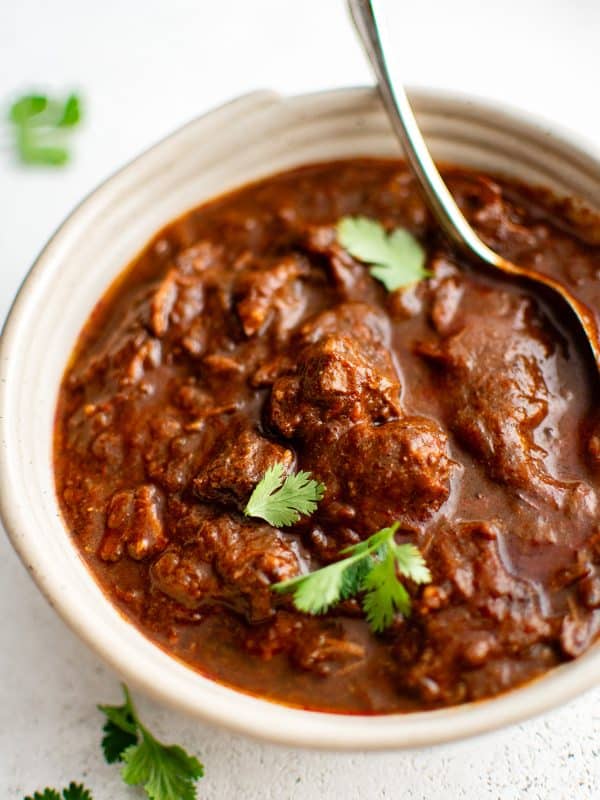








Thanks for the recipe. Growing up in Pittsburgh, PA as Croatian American, my family would have Bacala/Stockfish on Christmas Eve. My Dad would actually use a saw from our tool shed to cut it into small portions. Then cook it for two days on the back porch, in an electric roaster, adding water every couple hours as it evaporated. Finally on Christmas Eve, for supper my mother would prepare a pan with a ton of olive oil, garlic and boiled potato, mix in “The Buc”, add salt and pepper, and WOW!! Very delicious……..needless to say our family would go to midnight Mass stinking from garlic and fish. The Good Old Days!!
Tonight I am making salt cod, after soaking and changing the water for the past three days. Will prepare with olive oil, hot pepper flakes, garlic, diced red onion, and boiled potato. Much less work than the stockfish, with similar result. Can’t wait to dig in.
Your childhood soup sounds amazing and I love hearing that story 😀
I hope you enjoy this soup!
Was not a soup. Just all sauteed in a pan with olive oil.
That sounds even better, I will have to look into that recipe 🙂
Hi-
Making this right now w Canned tomatoes. Do I drain the liquid from the van?
Thanks!
When making bacalao with canned tomatoes, I typically recommended to use both the tomatoes and their liquid. The liquid adds extra flavor and moisture, which helps to create a rich, savory sauce for the bacalao. However, if you prefer a thicker sauce or wish to reduce the tomato flavor, you can drain some or all of the liquid according to your taste preference.
This has become our Holiday meal now!
Thank you for a terrific recipe.
Yes we do the variations: Kalamata, tomato juice, butter, carrots.
Tomorrow I am adding some leeks and sliced tomatillo discs, so healthy.
Our menu for tomorrow is your fish soup, garlic bread, zucchini farci, and meatballs with rice.
Merry Christmas. Peace on Earth.
Have not made your recipe yet but looking forward to it. I have been a fan of salt cod for quite awhile.
One question, I have a pound of dried cod. I assume the weight for the amount for the recipe is the dried one, not once hydrated
Correct 🙂
This is the 3rd time I am making this! We love it. As seaside people now living inland it is the perfect answer to our longing!
I use fresh tomatoes and a little tomato juice or tomato soup. Also, we opt for kalamata olives to add a dusky counterpoint.
Thank you for the great feedback and rating 🙂
We just returned from Norway and my husband absolutely loved the Bacalao from Bacalao restaurant in Svolvaer. I’m excited to try your recipe as a surprise for him!
My husband and I also loved the Bacalao from Bacalao restaurant in Svolvaer Lofoton! 😀
Hi,
No one has told me the one most important thing! How do you bloody well cut the dry fish?
Do I use the chain saw, band saw, or will an axe do? Why not one of the recipes on the whole internet tell us how to cut it! I have the whole fish, it’s Norwegian, and it’s like a piece of hardwood!
Please add the answer to your recipe.
Eric Ozgo
Great question Eric – please see Step #1 in the Bacalao recipe card above: “Soak the Salt Cod” . The salt cod needs to be soaked at least 24 hours, with water changes, so that you don’t have the bring out the Axe 🤣
🤣 You can do the over night soak… changing water 3 times. When I use for stew so like to retain a small amount of the salty flavor so I will just rinse it and then boil it and rinse it again. If you do the soak you can add a little milk too. And don’t worry if it seems rubbery. After you boile the finals he’s product it will be flakey and delicious!
My in laws would cut it in pieces and soaked for several days . We would then slow cook it with different root vegetables to a soft constancy and clean it from the bones and dark meat skins. The dark meat would be for the soup with rice or potatoes with some lemon juice and spices.
The other way is to use the cleaned bacalao is with lots of spices parsley, extra virgin olive oil, some broth from the cooking and tons of garlic to make it like a salad consiistancy
Been buying salt cod off and on for years and this is the best recipe I’ve come across – it did help that for once I started the soaking process the night before though! I skipped on the sherry and used a good fish stock instead. Loved the addition of sweet peppers and black olives.
I agree. There are SO MANY variations and I love this one the most by far.
Thanks for the feedback and rating Apryl 🙂
Love the stew, it’s easy to make and very flavorful!
I made Bacalao for the third time this evening, since we moved to Norway six weeks ago. But today time was not on our side and I needed a short cut. We’d bought Rød Morene potatoes, these are local, claret-coloured, hard and waxy; they proved very good too. We’d bought cod fillets too, though not salted. To cut the time, I sliced the potatoes, covered them in cold water in a sauce pan, brought them to a boil, covered the pan and turned the heat to very low for 18 minutes. While the potatoes were taking care of themselves I got to work with a Le Creuset casserole, ( dutch oven, if you prefer ) olive oil and the other ingredients of the sauce; I had that ready and reduced to simmering just as the potato’s timer announced that they were ready too. Potatoes went in first, followed by the fish. Back to a brisk simmer and ten minutes later my wife and I sat down to what proved to be another enjoyable meal. Preparation and cooking took just over an hour. The other good news is that we’ve enough left for another meal during the week.
I love leftover Bacalao as well, thanks for the detailed comment/feedback Robin 🙂
Just found some salted mahi mahi (dorado fish in spanish) and can’t wait to make this recipe!
As for the fact that alcohol can’t be found readily in Norway, no wonder the Norwegian dude I met here in Ecuador more than a decade ago – he got real crazy down here with the over-abundance of alcohol!
Thanks for the recipe.